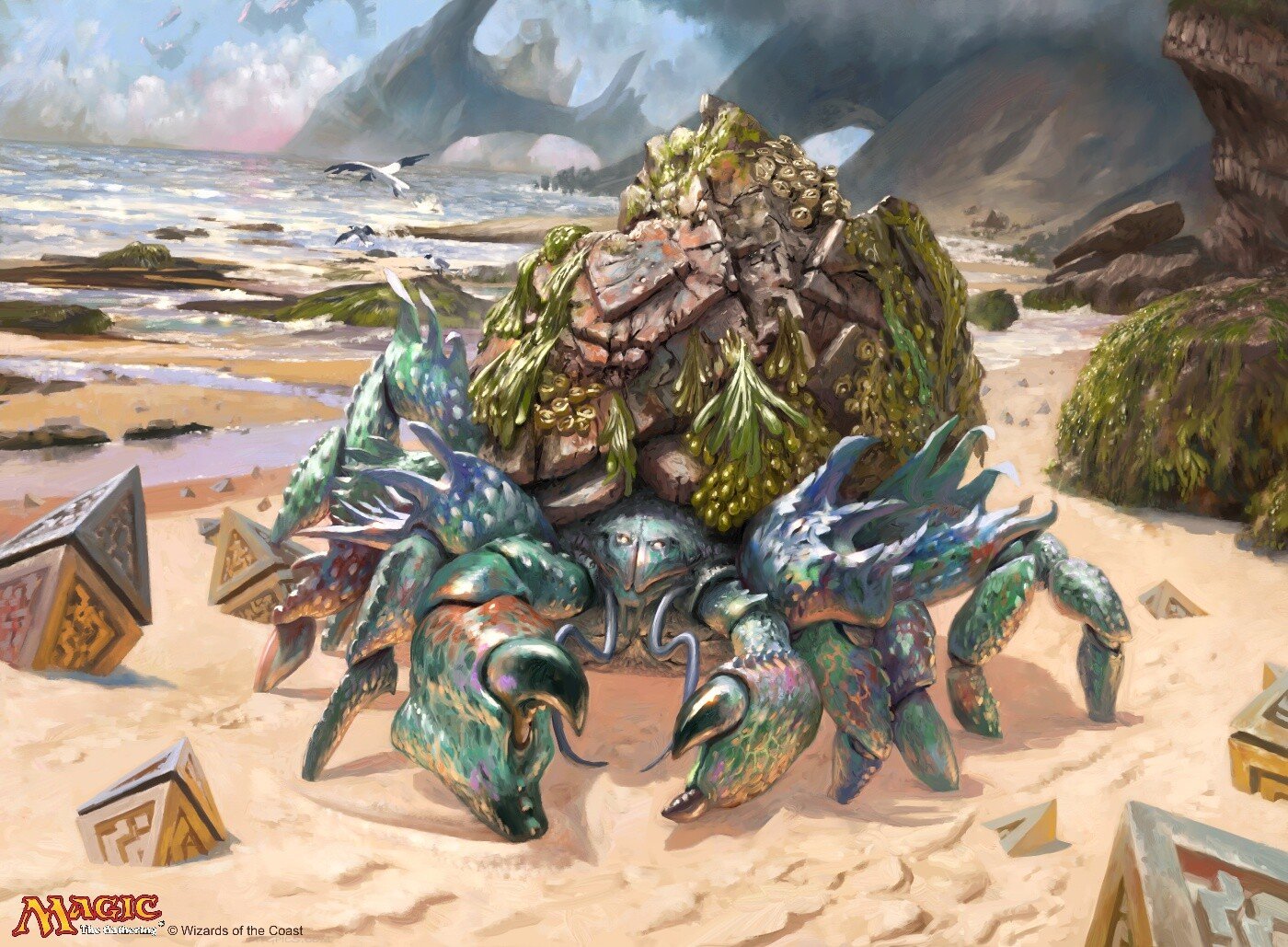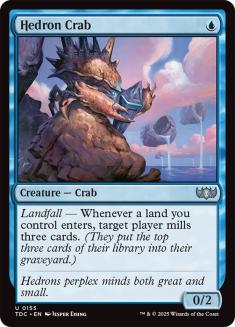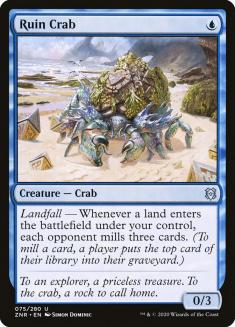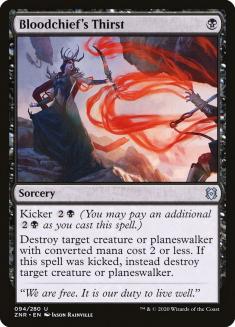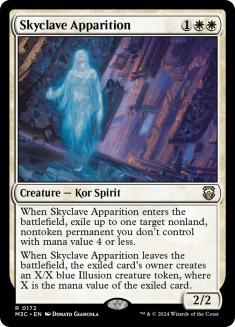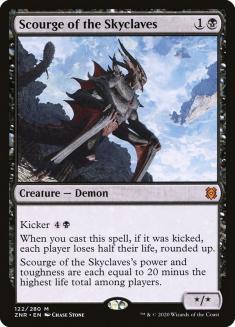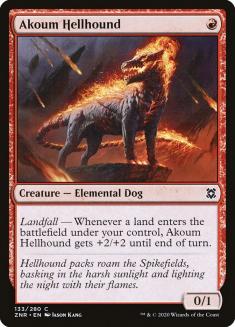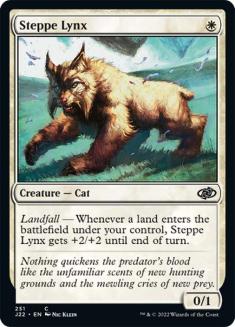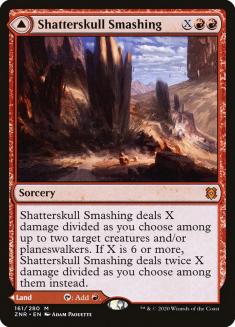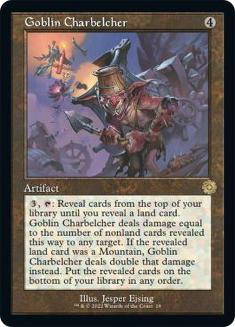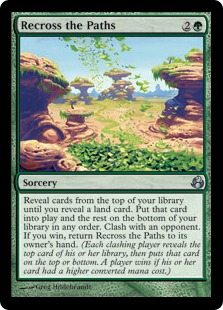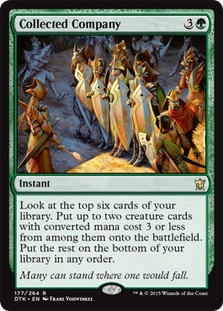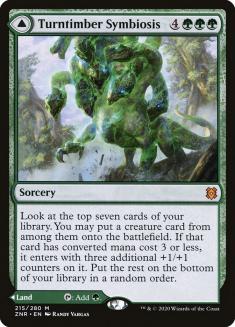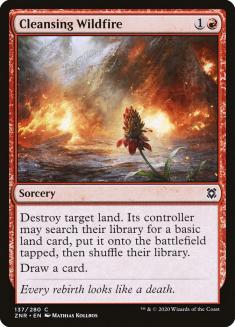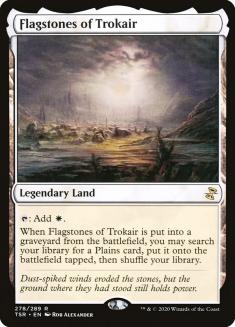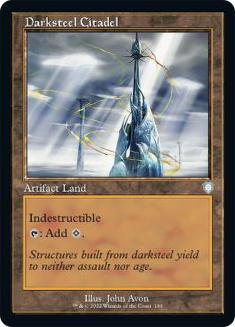Sequels invite the obvious comparisons. Before Modern was a glint in Gavin Verhey’s eye, Zendikar revolutionized Extended — and not just with the long-awaited enemy-colour fetchlands. Years later, Battle for Zendikar had only a minor impact on Modern until Oath of the Gatewatch unleashed an Eldrazi invasion. Early indications are that Zendikar Rising is more of a Zendikar in all the best ways — judging by the first weekend of tournament results, Modern is no exception:
Creatures (8)
Planeswalkers (2)
Lands (22)
Spells (28)

A fan favourite but rarely a real contender, ‘deck damage’ has always stacked up poorly to actual damage; you have fewer options (specific mill effects versus anything that can attack) to clear a higher bar that the opponent won’t significantly lower with cards like shocklands or Thoughtseize that are omnipresent in Modern. Although the best mill cards can rebalance that equation — Glimpse the Unthinkable does a decent impression of Boros Charm — it was ultimately too hard for Dimir Mill to cross its unique finish line consistently. With ‘mill’ now officially cemented in Magic’s lexicon, it’s only fitting that the archetype should start racking up results with the help of some new arrivals:
Though it gave otherwise dead removal spells an appealing target, Hedron Crab threatened a higher ‘damage’ output than any other card in conjunction with fetchlands; Field of Ruin; and Oboro, Palace in the Clouds. When Hedron Crab is good, it’s the scariest possible card to face from Dimir Mill. Ruin Crab makes that much more likely and opens up the double Crab draws that can end games swiftly even with few resources.
This creates a dilemma for opponents who need to respect this cast of Crabs without slowing down their hands with useless removal spells against the spell-based Dimir Mill draws. Just as Baral, Chief of Compliance joining Goblin Electromancer allowed Gifts Storm to build around having a cost reducer in most games, Ruin Crab lets Dimir Mill lean much more on Hedron Crab.
Mill isn’t the first deck that jumps to mind as a home for Bloodchief’s Thirst but Modern’s newest removal spell addresses its glaring weakness to aggressive decks — you already have a structural advantage against control, combo, and ramp but desperately hope to avoid Monastery Swiftspear or Champion of the Parish. For that reason, Bloodchief’s Thirst may be a more important pickup than any new ramp spell, as it offers important backup for Fatal Push in those matchups.
It’s generally weaker than Fatal Push, yes, but until they let you play eight copies of Fatal Push there’s room for the likes of Bloodchief’s Thirst to keep the bench warm. This redundancy also offers a boost to base-black strategies like classic Golgari Midrange or Death’s Shadow, which suffered from black somehow lacking a good one-mana removal spell before Aether Revolt changed everything.
Mill’s potential in Modern is inherently limited — its matchups are still heavily polarized despite this additional interaction, and sideboard hate cards like Gaea’s Blessing or the Rise of the Eldrazi titans offer a Leyline-esque effect against Mill without even needing to be drawn — but it’s the perfect deck to take a tournament by surprise, as TheEnzym did last weekend.
Creatures (32)
- 4 Drogskol Captain
- 3 Rattlechains
- 4 Spell Queller
- 2 Selfless Spirit
- 4 Mausoleum Wanderer
- 4 Supreme Phantom
- 3 Giver of Runes
- 2 Unsettled Mariner
- 2 Shacklegeist
- 4 Skyclave Apparition
Lands (22)
Spells (6)
Sideboard

After a brief period of air superiority, Azorius Spirits and Bant Spirits gave up the ghost and have rarely been seen since despite a steady stream of pushed cards that care about flyers or Spirits. Skyclave Apparition has finally brought the archetype back from the dead. In their competition for the title of Modern’s best tribal deck, Humans leaned heavily on Reflector Mage, a card often used in Spirits despite its lack of tribal applications due to the importance of that effect. Skyclave Apparition is better for Spirits than Reflector Mage ever was for Humans; it’s difficult to exorcise an Apparition at all thanks to Rattlechains, Drogskol Captain, and Unsettled Mariner, and it leaves behind a non-flying creature that can’t block your air force.
Wide-ranging removal on a cheap body is also valuable for any creature toolbox deck with white mana; a Collected Company, Eldritch Evolution, or Chord of Calling is now much more versatile. As the format shifts with an influx of new cards, this is a useful hedge against the unknown. This Azorius Spirits player may not have expected to face Mesmeric Orb or Hardened Scales this weekend but could count on Apparition as a safety valve.
The Skyclave isn’t done making its mark on Modern:
Creatures (20)
Lands (18)
Spells (22)

The original Zendikar block brought one of the strangest cards in all of Modern in Death’s Shadow, a cornerstone of several decks but not one that’s easy to find redundancy for. Scourge of the Skyclaves gives a rough approximation of that at least. Damaging yourself isn’t enough here, as an opponent that can stay at a high life total can keep Scourge small or stop it being cast altogether. This rules it out for traditional Grixis Death’s Shadow and points us towards aggressive Death’s Shadow decks that actually sport other creatures:
A decade later, Steppe Lynx remains one of the best aggressive one-drops of all time; Akoum Hellhound shows there are many ways to reskin a cat in a colour that better supports its style of aggression. Its most obvious home is alongside Steppe Lynx and your choice of Goblin Guide, Wild Nacatl, or the usual prowess suite in Landfall Aggro — which is now capable of scarily consistent Turn 3 kills — but Scourge of the Skyclaves may be a more promising route. Japanese deckbuilder Atsushi Ito (better known as matsugan) earned his mad scientist badge by building the original Death’s Shadow Aggro list that splashed a fourth colour for Steppe Lynx in a seventeen-land aggro deck, but nothing so wild is required now; this new version boasts a clean manabase and the biggest creatures across its compressed curve at the same time.
In a set that’s all about lands, some of the best lands are masquerading as something else:
Until now, Goblin Charbelcher was just a gimmick in Modern. Getting to four or seven mana with the likes of Pyretic Ritual is hard enough but casting Pyretic Ritual at all is even harder without Legacy’s abundance of artifact mana and cards like Land Grant that could cheat Goblin Charbelcher’s implied land count cap.
The modal double-faced cards (DFCs) are game-changers for many reasons, but for Goblin Charbelcher they function as a technicality. Shatterskull Smashing is a ‘land’ that Goblin Charbelcher ignores as it churns through your library. A full roster of modal DFCs allows Gruul Charbelcher to have both a semi-normal manabase and its namesake, one of the most powerful but restrictive finishers in Modern.
One of Modern’s charms is that it contains templating relics from a bygone era. Recross the Paths lacks the ‘in a random order’ clause that would surely be there these days and confirm its status as a fifteenth-pick Morningtide Draft reject, meaning that it allows you to stack your deck if you somehow manage to avoid putting lands in it. This sets up Reforge the Soul as a predicted Miracle finding enough acceleration to cast and activate Goblin Charbelcher as well as a truly inspired alternate win condition of Collected Company for Undercity Informer and Thassa’s Oracle.
An eye-catching feature of this deck is that it gets to play some of Modern’s best sideboard cards. Blood Moon and Leyline of Sanctity are the most feared cards across seventeen years of sets for many Modern decks, while a full clip of Veil of Summer in the maindeck gives some protection against Thoughtseize and Force of Negation. The modal DFCs add some unexpected but useful options — committing to the battlefield in a bid to win before a Charbelcher can open you up to a Irencrag Feat fueling a large Shatterskull Smashing, while Spikefield Hazard can snipe an early Noble Hierarch or Thalia, Guardian of Thraben. Attacking five times with Akoum Warrior is a passable Plan F if it comes to that!
Other decks use the modal DFCs in a more balanced way:
Creatures (15)
Lands (32)
- 2 Forest
- 1 Wooded Foothills
- 2 Snow-Covered Forest
- 2 Golgari Rot Farm
- 4 Gruul Turf
- 1 Ghost Quarter
- 4 Simic Growth Chamber
- 1 Vesuva
- 1 Tolaria West
- 2 Valakut, the Molten Pinnacle
- 1 Verdant Catacombs
- 1 Bojuka Bog
- 2 Cavern of Souls
- 1 Radiant Fountain
- 1 Crumbling Vestige
- 1 Hanweir Battlements
- 1 Field of the Dead
- 4 Castle Garenbrig
Spells (13)

After reigning over Modern once again for a few glorious months, Amulet Titan has become an old romance whose passion is suddenly and intensely reignited when the time is right. Though these latest developments are disturbing — disruptive aggro-combo decks, faster combo, and Mill of all things — it gains a promising new tool in Turntimber Symbiosis.
Among Amulet Titan’s many moving parts, two of its major choke points are its threat count (to be expected with only eight copies of the main payoff) and land drops, a surprisingly common problem for a deck with upwards of 30 lands including some double-counting with the Ravnica bouncelands. Symbiosis neatly addresses both while also operating as an all-important untapped green source for Sakura-Tribe Scout in builds that run it.
The odds on Symbiosis aren’t too inspiring — you’re at just around 50% to hit Primeval Titan if you haven’t drawn one by the time you’re likely to cast it — but additional copies of Valakut, the Molten Pinnacle make Dryad of the Ilysian Grove an acceptable hit sometimes. Notably, you can park Turntimber, the Serpentine Wood on the battlefield to avoid discard and turn any topdecked bounceland into a possible threat later.
Any deck hoping to use lands in creative ways has to consider a new marquee land destruction card:
Recent years have seen many cards clearly designed with Tron and other big-mana strategies in mind: Damping Sphere, Alpine Moon, and Assassin’s Trophy, to name just a few. Any Tron pilot can testify that these are minor annoyances unless accompanied by other disruption or pressure. Many players have kept weak hands relying on these cards, only to witness Karn Liberated’s smug grin before long anyway. As a known Karn sympathizer, Cleansing Wildfire has me making this face:
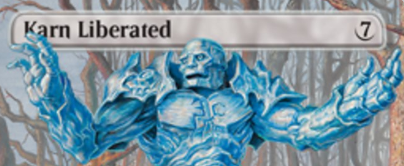
Cleansing Wildfire replacing itself automatically makes it a stronger card than other similar effects, and the fact that it can be cast before Tron is assembled without disrupting your own gameplan makes it a go-to for anyone hoping to revoke Karn’s freedom. Cleansing Wildfire being a Mystic Sanctuary target may be enough to swing the matchup for blue control decks more than any card until now. If only this were 2015 and Jeskai Control were still playable hold on, I’m hearing some strange news?!
You can convert Cleansing Wildfire into the best Rampant Growth ever with only minor changes to your manabase, raising its floor significantly. It’s often the best Stone Rain of all time too — most decks that don’t really want a basic land have at least one out of respect for Field of Ruin and friends (unless their entire manabase is modal DFCs…) but with enough copies of these effects you can run your opponent out of basic lands quickly. Cleansing Wildfire can fill the role Spreading Seas used to play in Modern blue decks — proactive, cantripping mana disruption that sometimes effectively ends the game at the low cost of two mana.
A card dominating Standard is a good predictor for success on bigger stages these days and the appeal of Omnath, Locus of Creation is clear in a fetchland format where its fast friend Uro, Titan of Nature’s Wrath is notoriously powerful. Omnath’s latest and greatest incarnation has already piqued the interest of an accomplished deckbuilder:
This list looks like an attempt to prove that you can win tournaments without ever being able to cast your spells — supporting Omnath, Cryptic Command, and Field of the Dead in a deck that also has other colourless lands and ‘only’ 28 total lands is ambitious. The Four-Colour Control core from before the Field of the Dead craze is a more natural starting point:
Creatures (7)
Planeswalkers (5)
Lands (28)
Spells (20)

Hour of Promise for Field of the Dead found its way into these decks because they could have trouble closing the game or establishing inevitability without Uro. Felidar Retreat is a fine replacement that doesn’t mangle your manabase and lets your 2/2s punch through theirs in the pseudo-mirror.
If we do want to retain Hour of Promise, there’s another shell that welcomes Omnath with all four of its open arms:
Creatures (13)
- 2 Wall of Blossoms
- 4 Uro, Titan of Nature's Wrath
- 4 Dryad of the Ilysian Grove
- 3 Omnath, Locus of Creation
Planeswalkers (4)
Lands (30)
- 1 Forest
- 1 Island
- 4 Flooded Strand
- 1 Snow-Covered Plains
- 1 Snow-Covered Mountain
- 1 Snow-Covered Island
- 1 Snow-Covered Forest
- 1 Oboro, Palace in the Clouds
- 1 Temple Garden
- 1 Steam Vents
- 1 Breeding Pool
- 1 Hallowed Fountain
- 4 Misty Rainforest
- 2 Scalding Tarn
- 3 Valakut, the Molten Pinnacle
- 1 Celestial Colonnade
- 2 Field of the Dead
- 1 Mystic Sanctuary
- 1 Ketria Triome
- 1 Raugrin Triome
Spells (13)
Sideboard

It feels like a decade ago that I began writing regularly for Star City Games with a preview article on Dryad of the Ilysian Grove’s applications in Modern. We’re starting to learn just how Dryad enables Omnath in Standard and that scales very well here. It feels trivial to say that Omnath does everything, but it has a useful function here as a threat that works with your deck’s main plan but can also take over by itself when that plan is off-limits.
If we’re already stretching into four colours for Omnath, why not the fifth?
Creatures (9)
Planeswalkers (6)
Lands (26)
Spells (19)

Five-Colour Niv-Mizzet wasn’t lacking top-end firepower before — if anything, most lists probably leaned too far in that direction — but it makes better use of Omnath’s mana generation than any other deck. Fetching a black source allows Omnath to chain into a fully powered Bring to Light or Niv-Mizzet Reborn for ‘free’ on the turn it’s cast (often on Turn 4 thanks to Utopia Sprawl or Uro, Titan of Nature’s Wrath).
Drawing too many five-drops was an issue for previous builds that maxed out on both namesakes; Omnath can rival the power of either as a four-drop that mitigates the deck’s clunkiness by enabling double-spell turns. Glittering Wish now finds a threat that stabilizes the game sooner along with the usual range of tools that dismantle decks hoping to avoid the fair fights that Five-Colour Niv-Mizzet dominates.
After a string of sets that completely changed Modern as we know it, Zendikar Rising looks to be a refreshing change of pace. Many exciting new cards will have a long-lasting impact on Modern without warping it beyond recognition.

